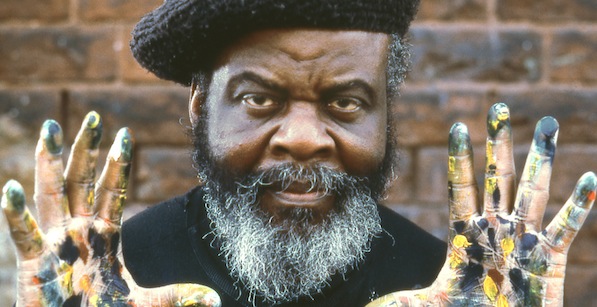Before Thomas G. Miller made movies, he was a pediatrician in Cleveland for almost nine years. At 35 years old he developed arthritis in his vocal cords, making him susceptible to respiratory infections from his patients, and physically unable to continue practicing medicine. In his statement for his acclaimed documentary One Bad Cat, he says:
At 35, after many years of study, my life was at a crossroads. At that point I had two choices, either wallow in depression or accept my current circumstances and create a new life. I did what any sane person would do, I applied to the USC School of Cinematic Arts. I got an MFA in film production and begin working on documentary films. I discovered I possessed a stronger “voice” than I ever had before.
Miller goes on to talk about why he was inspired to make One Bad Cat, a film about the late artist Albert Wagner:
When Reverend Albert Wagner was 50, he also came to a turning point in his life. He was a highly successful, talented, gregarious man who let his indulgences lead him to the edge of the abyss. Like me, Albert had to choose how he was going to survive the rest of his life. This is one of the main reasons I wanted to make One Bad Cat, to tell this unique story about Albert’s spiritual and artistic transformation during his personal quest for salvation.
Miller has this to say about his film in an interview with Anne Price for About.com:
What do you feel the story and narrative ultimately turned into over time?
The question became: can you be transformed by art? I feel that’s the theme of the film. Some people think you can and some think you can’t. For him, I think he was transformed through it. That, and through his ministry. He tried his best to preach and live a life of positive influence according to his beliefs. In a documentary, you let the footage tell you what the story is about. If you’re open to what you’re shooting I think a documentary can be much richer. In the filming, I discovered his many transgressions in early-mid and mid-life. That helped explain what themes we were seeing his artwork. I saw mainly three themes running through them.
What do you feel those three themes were?
Well, one, the theme of growing up in the South: slavery, segregation, persecution, emancipation. That I did know about him already. The second was the sexual aspect to his art; works on the street, gamblers, prostitutes, women, crime. From years twenty to fifty he was witness to this life and perhaps, sometimes a participant. The third theme was religion and how his life changed; we see it in Biblical scenes, lessons he wanted to teach. He didn’t do any artwork until he was 50 and these themes were intertwined through his career.
He was conflicted and human, but who isn’t? He tried the best he could to overcome compulsions that affect men, and women: ego, greed, lust. I said last night (at the House of Blues special friends and family preview of the film) that I was happy to be given this film and subject, but basically they gave me a man who didn’t leave his room and was at times, difficult to find likeable.
You mentioned earlier you were a doctor. How did you go from medicine to film?
I grew up in Shaker Heights and then went to medical school and practiced in pediatrics. I developed arthritis in my vocal chords and had to have a tracheotomy. Because of that, I was getting sick all the time from exposure to patients with illnesses. Because there’s no filter with the tracheotomy I was prone to respiratory infection. I was already taking classes at John Carroll University and consulting for Sesame Street. They were introducing a baby to the show and I was advising them on a child’s natural growth and development. I knew I didn’t want to practice medicine any longer. I just felt I needed a break and wanted to get into warmer weather for my lungs. I’d had three years to come to grips with what happened to me. Decided to go to USC film school in Santa Monica; I fell in love with documentaries. To me, it’s the last place for freedom of speech; you may not agree with a documentary but it isn’t filtered. That’s why I love it. It gives people the chance to explore interesting subjects and it’s a place for people to explore their passions. I teach at USC School of Cinematic Arts and am a board member of the International Documentary Association, a non-profit organization.






